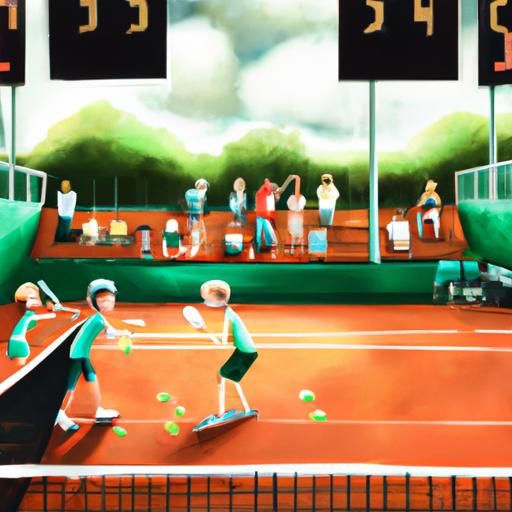Are you an avid tennis player? Are you concerned that your racket might be going bad? Whether you’re a weekend warrior or a professional athlete, it’s important to know what happens to a racket over time and what signs to look for that indicate it might be time for a replacement.
In this article, we’ll discuss what happens to tennis rackets over time, the signs that your racket has gone bad, maintenance and care steps to extend the life of your racket, proper storage techniques, and when it’s time to say goodbye to your old racket and buy a new one.
So grab your racket and let’s get started!.
Table of Contents
Do Tennis Rackets Go Bad?
Yes, tennis rackets can go bad.
Over time, the strings will wear down and lose their tension, making it more difficult to hit the ball accurately.
The frame can also become warped or cracked due to wear and tear.
What Happens to Tennis Rackets Over Time?
Tennis rackets are essential tools for any tennis player.
They are made from a combination of metal, plastic, and other materials, so they can wear down over time.
Therefore, it is important for tennis players to take the necessary steps to maintain their rackets, not only to extend their lifespan but to ensure the highest level of performance.
The strings of a tennis racket are one of the most important components and can stretch and weaken over time, reducing the tension and making them less powerful.
If this is not addressed, the strings can break during play.
The frame of the racket can also become bent or warped over time, affecting how the racket performs and how it feels to the player.
The grip of the racket can become worn down and slippery over time, making it difficult to maintain control of the racket.
In order to keep the racket in good condition, regular maintenance is essential.
This includes cleaning the racket and regularly checking the strings for any signs of wear and tear.
Proper storage of the racket is also essential to keep it in good condition; it should be kept in a dry and cool place to avoid warping or rusting.
In addition to regular maintenance, regular inspection of the racket can also help to identify any potential issues that may need to be addressed.
This could include checking for signs of stretching, weakening, or warping of the strings, frame, and grip.
By following these simple steps, tennis players can ensure that their racket is in the best possible condition, allowing them to perform at their highest level.
Signs That Your Racket Has Gone Bad

Playing tennis is a great way to stay active and improve your physical and mental health.
But, in order to maximize your performance and keep your racket in top condition, it is important to pay attention to maintenance.
From strings to frame to grip, there are several components of a racket that can become worn down or damaged over time, leading to a decrease in power and accuracy.
The strings of a racket are essential for providing tension and power.
However, over time, strings can become loose and stretched, leading to a decrease in power and accuracy.
It is important to regularly inspect the strings for any signs of wear and tear and replace them if necessary.
The frame of the racket is what gives it its shape and structure.
If the frame becomes bent or warped, it can lead to a decrease in control and accuracy when hitting shots.
It is important to check for any signs of damage to the frame and fix it if necessary.
The grip of the racket also plays an important role in providing comfort and control when playing.
If the grip becomes worn down, it can make it difficult to hold the racket effectively.
It is important to regularly inspect the grip and replace it if necessary.
The paint job of the racket also affects its aesthetic value.
If the paint job begins to chip, it can significantly reduce the racket’s appeal.
It is important to regularly inspect the paint job and touch up any chips or scratches.
Finally, scratches and dents in the racket can affect its aerodynamics.
It is important to inspect the racket for any signs of damage and fix them if necessary.
Regular maintenance and proper storage of the racket are essential for maximizing performance and extending its life.
It is important to inspect your racket regularly for any signs of damage or wear, and replace or fix components if necessary.
Maintenance and Care to Extend the Life of Your Racket
Racket maintenance is an essential part of ensuring that your racket remains in good condition and performs well for many years.
With the proper care and attention, your racket will provide you with optimal performance and comfort.
Here are some tips for taking care of your racket: Regularly inspect your racket for signs of damage and wear, such as frayed strings, bent frames, and worn grips.
It is also important to routinely check the tension of the strings and adjust them as necessary.
After each use, make sure to clean and wipe down the racket.
When not in use, it is important to store your racket in a cool, dry place to avoid damage from heat, humidity, and other environmental factors.
A racket cover can also help protect it from scratches and dust.
If your racket is exposed to wet and humid conditions, you may consider using a specialized racket protector to keep it dry and prevent damage.
It is also important to use a racket dampener to reduce vibration and shock to the frame and strings, thus prolonging their life.
Additionally, it is a good idea to replace your grip periodically to ensure maximum grip and comfort.
Applying a specialized lubricant to the strings can also help to reduce friction and wear and tear.
By following these simple tips, you can help ensure that your racket stays in optimal condition and lasts for many years.
Racket maintenance is an important part of the game, and with proper care, you can ensure that your racket provides you with the best performance possible.
Proper Storage for Your Racket

Taking care of your tennis racket is an important step in ensuring that it will last you for years to come.
Proper storage of your racket can make a huge difference in its longevity and performance.
Here are some tips on how to store your racket to ensure its optimal condition.
When storing your racket, it is important to ensure that it is in a cool, dry, and dust-free place.
High-quality racket bags or cases are the best way to protect your racket from physical damage.
For extra protection, consider using a racket cover or guard.
Avoid storing your racket in extreme temperatures or high levels of humidity, as these can cause the strings and frame to weaken or warp over time.
If you plan on not using your racket for an extended period of time, it is advised to clean and re-string it before storing it.
Rackets should be stored with the strings facing up and away from direct sunlight.
To avoid warping or bending of the frame, the racket should be stored horizontally.
Additionally, it is important to avoid placing any heavy objects on top of the racket.
Finally, the grip should be kept away from wet or damp surfaces, as this can cause it to become slippery or cracked.
By following these simple storage tips, you can help ensure that your racket will remain in optimal condition and perform at its best.
When to Replace Your Racket
Tennis is a sport that requires skill and technique, but it is also important to have the right equipment.
Your racket is one of the most important pieces of equipment, and it needs to be taken care of and replaced regularly.
Here is what you need to know about when to replace your tennis racket.
The most common reasons to replace your racket are due to strings stretching and weakening, frame bending or warping, or grip wearing down.
It is important to inspect your racket regularly and look for signs that it may be time for a replacement.
These signs include strings feeling looser than usual, frame looking bent or warped, or grip feeling slippery or worn down.
If you are a competitive player, it is important to have the best equipment.
Therefore, you may want to replace your racket if you have had it for more than a few years.
Additionally, regular maintenance of your racket is key to extending its life.
You should store it in a cool, dry place and avoid leaving it out in the sun or in hot cars.
You should also replace your strings once they start to lose their tension.
When determining when to replace your racket, there are several factors to consider.
These include the age of the racket, the condition of the strings, any signs of damage to the frame, such as warping or bending, and the condition of the grip.
You should also look out for signs that it is time to replace your racket, such as poor performance during play, difficulty controlling the ball, uneven string tension or fraying of strings, and visible damage to the frame or grip.
The bottom line is that it is important to replace your racket when necessary.
Regular maintenance and inspection can help extend its life, but if you notice any signs of wear and tear, it is time for a new one.
Final Thoughts
It’s important to understand that tennis rackets don’t last forever.
With regular maintenance and proper care, you can keep your racket in good condition and extend its life.
Pay attention to the signs that your racket has gone bad, and don’t hesitate to replace it when necessary.
By taking the time to inspect your racket and store it correctly, you can make sure you’re playing with the best possible equipment.

